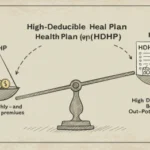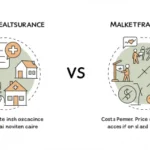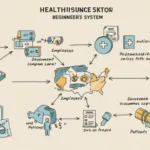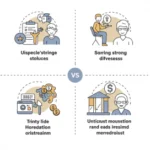Health insurance costs are rising every year, and 2025 is no exception. For many Americans, monthly premiums are one of the biggest expenses they face — especially for individuals without employer-sponsored plans. The good news is that there are several smart ways to reduce your health insurance premiums without sacrificing essential coverage. In this article, we’ll break down proven strategies to help you save money on health insurance this year.

1. Choose a High-Deductible Health Plan (HDHP)
One of the most effective ways to reduce your monthly premium is by choosing a high-deductible health plan, or HDHP. These plans come with lower premiums but higher out-of-pocket costs when you receive care.
If you’re generally healthy and rarely visit the doctor, an HDHP might save you thousands of dollars annually. In addition, HDHPs are compatible with Health Savings Accounts (HSAs), which allow you to save pre-tax money for medical expenses.
Tip: Always compare the total annual cost — not just the monthly premium. Sometimes, a plan with a higher deductible still ends up being cheaper over the course of a year.
2. Enroll Through the Health Insurance Marketplace
Many people qualify for subsidies when enrolling in health insurance through the federal or state marketplaces (like Healthcare.gov). These subsidies, called “premium tax credits,” can significantly reduce your monthly cost — especially if your income falls within the qualifying range.
Even middle-income individuals and families may now qualify due to recent federal updates. If your annual income changed in 2024 or 2025, it’s worth revisiting the marketplace to check your eligibility.
Tip: Always report your updated income and household size to ensure you get the right subsidy level.
3. Consider a Bronze or Silver Plan
Health insurance plans are categorized into four metal tiers: Bronze, Silver, Gold, and Platinum. Bronze and Silver plans typically have lower monthly premiums than Gold or Platinum plans.
While Bronze plans have higher deductibles, they’re often a better fit for younger or healthier individuals who only need coverage for emergencies or preventive care.
Silver plans may be ideal if you qualify for cost-sharing reductions, which lower your deductible and co-pays automatically.
Tip: If you’re eligible for both premium tax credits and cost-sharing reductions, a Silver plan could provide the best value.
4. Use a Health Savings Account (HSA)
If you choose an HDHP, you can also open a Health Savings Account. HSAs allow you to set aside money before taxes to pay for qualified medical expenses.
Not only do you save money on taxes, but you can also grow your HSA funds over time — many accounts even offer investment options. Unlike Flexible Spending Accounts (FSAs), HSAs roll over year to year.
Tip: Contributing to an HSA reduces your taxable income, potentially qualifying you for additional insurance subsidies.
5. Compare Plans Annually
One of the most common mistakes people make is staying with the same plan year after year. Insurance providers often update their networks, premiums, and deductibles each year. What worked well in 2024 might not be the best choice in 2025.
It’s essential to compare your current plan with other available options during the open enrollment period, which usually starts in November.
Tip: Use tools like Healthcare.gov or work with a licensed insurance broker to compare options side-by-side.
6. Join a Spouse’s or Parent’s Plan
If your spouse or parent has employer-sponsored health insurance, joining their plan may be cheaper than buying one on your own. Family plans often provide better value per person, especially if the employer covers a portion of the premium.
For those under age 26, staying on a parent’s plan can be a great way to maintain full coverage while keeping costs low.
Tip: Compare the family premium + deductible with individual plan options before deciding.

7. Quit Tobacco (or Report Tobacco-Free)
Many insurance companies charge significantly higher premiums for tobacco users. If you’ve quit smoking or using tobacco, make sure your insurance provider updates your status — you could qualify for a lower rate.
Some insurers require a certain tobacco-free period (like 6 or 12 months), while others may request a health screening.
Tip: Consider tobacco cessation programs, which are often free and can reduce your insurance costs long-term.
8. Look Into Medicaid or CHIP Eligibility
Depending on your income and household size, you may qualify for low-cost or no-cost health coverage through Medicaid or the Children’s Health Insurance Program (CHIP).
These programs are available in every state and offer comprehensive coverage for those who qualify. Many people assume they don’t meet the criteria, but income thresholds vary by location and family size.
Tip: Apply through your state Medicaid office or visit Healthcare.gov for more info.
Conclusion
Paying less for health insurance doesn’t mean settling for poor coverage. By understanding how premiums work and exploring all your options, you can get the care you need while protecting your budget. Always compare plans, check your subsidy eligibility, and adjust your coverage as your life changes.
In 2025, being a smart consumer can make a meaningful difference in your financial and physical health. Don’t just accept your current rate — explore these strategies, and you may be surprised by how much you can save.

Hi, I’m Hibiki — the writer behind HealthManual.net.
I cover health insurance news, wellness tips, and insightful analysis of pharmaceutical and healthcare stocks. My goal is to simplify complex topics and make health and finance information more accessible to everyone.
Thanks for reading — I hope you find the content helpful and reliable.















